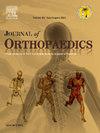运动学和机械单腔膝关节置换术髌骨对中比较
IF 1.5
Q3 ORTHOPEDICS
引用次数: 0
摘要
背景:单室膝关节关节炎的手术治疗通常采用单室膝关节置换术(UKA)。UKA可以通过更传统的机械校准来实现,也可以通过运动校准来实现。本研究的目的是比较机械式和运动学式UKA术前和术后髌骨肌腱对齐。方法对2015 - 2022年Medstar华盛顿医院中心156例部分膝关节置换术患者进行回顾性研究。其中95个有机械定位,61个有运动定位。术前和术后评估患者的install - salvati和blackburn - peel比率。关节成像x线成像分析由一名盲的msk训练的放射科医生进行。结果计算运动学和机械性膝关节置换术患者手术前后的install - salvati比率和blackburn - peel比率。运动对齐组的blackburn - peele手术比平均差0.089(±0.30),install - salvati手术比平均差0.18(±0.34),而机械对齐组的blackburn - peele手术比平均差0.054(±0.47),install - salvati手术比平均差0.41(±0.31)。运动学和机械性患者的手术install - salvati比值有统计学意义。此外,双样本t检验发现,运动对齐膝关节术后blackburn - peel比率和install - salvati比率存在显著差异,p值为2.33 × 10−16,低于0.05的显著性水平。双样本f检验发现,机械对齐和运动对齐膝盖之间的标准偏差与布莱克本-皮尔比有显著差异,p值为0.00183。结论:本研究表明,在比较blackburn - peel比率和Insall-Salvati比率时,矢状髌骨-股骨膝关节对齐在膝关节运动对齐时更准确地再现,并且在膝关节运动对齐时差异更大。本文章由计算机程序翻译,如有差异,请以英文原文为准。
Patellar alignment compared between kinematic and mechanical unicompartmental knee arthroplasties
Background
Surgical treatment of unicompartmental knee arthritis is typically treated by unicompartmental knee arthroplasty (UKA). UKA may be performed by more traditional mechanical alignment, or alternatively, kinematic alignment. The purpose of this study is to compare pre- and post-operative patellar tendon alignment between mechanical and kinematic UKA.
Methods
A retrospective study at Medstar Washington Hospital Center from 2015 to 2022 identified 156 cases of partial knee arthroplasties. Of these, 95 had mechanical alignments and 61 had kinematic alignments. Patients were evaluated pre and post-surgically for Insall-Salvati and Blackburne-Peel ratios. Analysis of joint imaging x-ray imaging was performed by a blinded MSK-trained radiologist.
Results
Pre-and-post-operative Insall-Salvati and Blackburne-Peel ratios were calculated for kinematic and mechanical knee replacement patients. The ratio differences for the kinematically aligned cohort demonstrated an average for Blackburne-Peele operative ratio difference of 0.089 ( ± 0.30) and an average Insall-Salvati ratio difference of 0.18 ( ± 0.34), whereas for mechanically aligned patients, the Blackburne-Peele ratio difference was 0.054 ( ± 0.47) and the Insall-Salvati ratio difference was 0.41 ( ± 0.31). There was a statistically significant difference in operative Insall-Salvati ratios between kinematic and mechanical patients. Additionally, a two-sample t-test found a significant difference between the postoperative Blackburne-Peel and Insall-Salvati ratios for the kinematically aligned knees with a p-value of 2.33 × 10−16 below the significance level of 0.05. A two-sample f-test found a significant difference in the standard deviation of the difference between mechanical and kinematically aligned knees with respect to the Blackburne-Peel ratio, with a p-value of 0.00183.
Conclusion
This study demonstrates that sagittal patella-femoral knee alignment when comparing Blackburne-Peel and Insall-Salvati ratios are more accurately reproduced with kinematically aligned knees, and a greater variability among the kinematically aligned knees.
求助全文
通过发布文献求助,成功后即可免费获取论文全文。
去求助
来源期刊

Journal of orthopaedics
ORTHOPEDICS-
CiteScore
3.50
自引率
6.70%
发文量
202
审稿时长
56 days
期刊介绍:
Journal of Orthopaedics aims to be a leading journal in orthopaedics and contribute towards the improvement of quality of orthopedic health care. The journal publishes original research work and review articles related to different aspects of orthopaedics including Arthroplasty, Arthroscopy, Sports Medicine, Trauma, Spine and Spinal deformities, Pediatric orthopaedics, limb reconstruction procedures, hand surgery, and orthopaedic oncology. It also publishes articles on continuing education, health-related information, case reports and letters to the editor. It is requested to note that the journal has an international readership and all submissions should be aimed at specifying something about the setting in which the work was conducted. Authors must also provide any specific reasons for the research and also provide an elaborate description of the results.
 求助内容:
求助内容: 应助结果提醒方式:
应助结果提醒方式:


